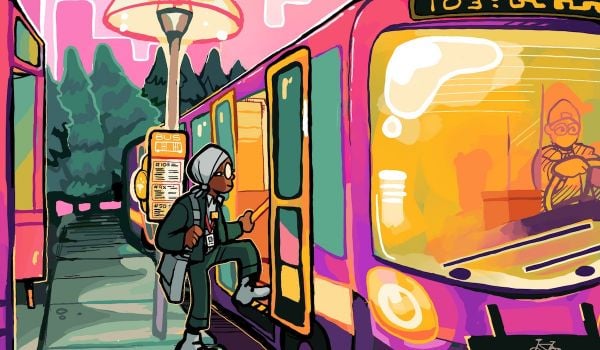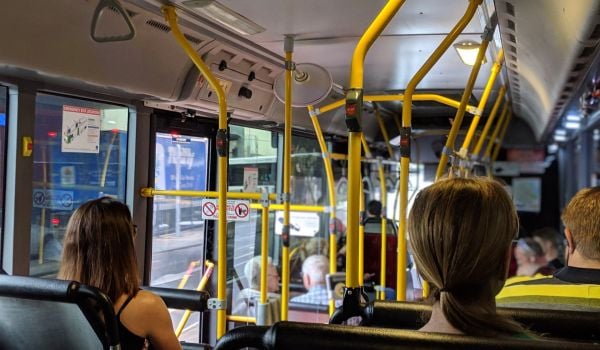The blow Maryland Gov. Larry Hogan dealt to Baltimore officials when he canceled state funding for the proposed Red Line crosstown light-rail route brought into sharp relief the haphazard history of transportation planning in that city. Neither all the freeways nor all the rapid transit lines the city had once envisioned got built: Community opposition killed some of the key freeways, and lack of a unified transit plan from the start turned what might have been a well-connected regional rapid transit system into a hodgepodge of not-quite-connected lines that got built according to what governments were willing to fund at the time.
Into this mishmash walks Archana Sharma, a professor of landscape architecture at the city’s Morgan State University, with some propositions for the future of Baltimore transportation planning. Fresh off a project to retrofit Easton, Maryland’s historic town center with green streets, Sharma got to thinking: Why stop with green streets? Technological change makes it possible to rethink completely how city streets should look and function.
“In thinking about green streets, green trails and green networks, I thought, all these are half-hearted attempts to come up with a comprehensive solution for street design,” she says. “In terms of technology, the changes around us and in the way we live are not being reflected in our transportation planning and design.”
To make things worse, she says, “transportation planners present variations on the status quo, and the public reacts. And Maryland DOT and the City of Baltimore both operate on a similar structure, where they have contractors for street markings, lighting and signage. Their concerns are mostly about banal functionalities and expectations of age-old transportation ideas,” by which she means the ability to move large numbers of motor vehicles through an area as quickly as possible, sometimes along with bikers and pedestrians depending on the street design, with a sprinkle of “sense of place” here and there.
Sharma’s “five steps to futuristic transportation planning and design” — which she’s also posted in the comments section of a U.S. DOT post titled “Join the Conversation. Help Us Go Beyond Traffic” — seeks to upend all this by looking beyond everyone’s current comfort zones. She hopes her set of propositions can spark a wide-ranging public debate involving people outside the usual transportation-planning orbit. That larger discussion in turn could generate the community support needed for a new comprehensive transportation plan for the long run. Her ideas strongly reflect her own background as a landscape architect but offer a useful starting point for a discussion — not only about what the streets of Baltimore should look like and do in the future but also about the function and appearance of streets in other cities.
Decluttering the Streetscape
One of the animating principles underlying Sharma’s five steps is decluttering the streetscape to give the natural and built environments more prominence. This forms the foundation of her first two steps: getting rid of all transportation-related street signage and making street furniture perform multiple functions. In place of signs bearing street names and traffic regulations, Sharma proposes putting this information into a “smart-sign card” that could be displayed on a smartphone or streetside screen. Citizens could purchase display cards if they do not have them, and they could also be displayed on car information screens and public transportation.
Some of these screens could be incorporated into multipurpose street furniture, her second step. “Why is a bus stop simply a bus stop?” she asks. “Why can’t it be a bench, and a trash can, and a solar power collector?” Not to mention one of those information screens.
Having the information screens incorporated into multipurpose street furniture addresses one of the problems with her signs-to-smart-displays idea, namely, that of equity: It’s not really fair to require everyone to have a personal smart device in order to view what should be basic, publicly accessible information. Even if, as she notes, technologies like smartphones that were once considered luxuries have become everyday items, not everyone considers them necessities yet, and some who might want them still can’t afford them.
Those multipurpose shelters, she says, could also be designed by local artists to add beauty to the streetscape.
Moving Toward Car-Free Cities
The other three steps have as a common goal removing another form of clutter on the streets, namely, all those cars. Sharma’s “step three” proposes replacing those cars with a network of ziplines hung at the second-story level, with balconies where users could board and alight. In addition to single-person suspended platforms, two- to four-person pods could also be hung from the ziplines for higher-capacity transit. Sharma acknowledges the “totally Asimovian sci-fi-ish” nature of this idea but stresses that progress often flies in on the wings of ideas currently considered unthinkable. Her argument is that bringing in visions from outside the conventional spheres of transportation thinking can advance the discussion in productive directions.
With the roads thus cleared of cars, one can rethink their very appearance and design, which is what steps four and five propose. Step four may be the most radical element of this proposal: It envisions completely rearranging the street space so that pedestrians take over the center and vehicles are pushed to the sides. One “sidewalk” could handle those motorized vehicles (including public transportation) that remain, while the other would handle bicycle traffic. Rain-garden buffers dividing the three sections would help control and reduce stormwater runoff, as would the permeable pavement segments proposed in step five. That step even goes beyond permeable pavement to ask the question, what if the vehicles carried their “pavement” with them, eliminating the need for large swaths of smooth, impermeable paved surface?
Again, these steps raise as many questions as they answer. One of them: If the goal is to declutter the streetscape, won’t those ziplines defeat that purpose?
“To my mind, maybe if we’ve removed the clutter from the ground, maybe some clutter in the air would be acceptable,” Sharma says. There are also some “streetscape clutter” issues the proposal doesn’t quite touch, such as the clutter caused by a jumble of signs on private buildings. That, she suggests, could be handled by developing signage standards for private businesses and storefronts.
The purpose of this exercise, Sharma reiterates, is mainly to provide food for thought and a springboard for discussion. “We aren’t going to solve the emerging transportation and civic design issues by thinking in the same old way,” she says. “We need to start thinking about the future in a concrete way.”
That includes the price tag and paying for it. Might a private entrepreneur take the lead on some of this, a la Elon Musk? Could a tax make aerial pod transport free of charge? Sharma is agnostic on the question except to note that “we haven’t really talked about money.”
Talking about money matters, of course. The Red Line’s backers will tell you that.
Sharma’s ultimate short-term goal is to get the conversation started in such a way that Baltimore will lead the way into the future instead of having the future imposed upon it. “If we don’t lead, Shanghai will, in a manner of speaking,” she says.
The Works is made possible with the support of the Surdna Foundation.

Next City contributor Sandy Smith is the home and real estate editor at Philadelphia magazine. Over the years, his work has appeared in Hidden City Philadelphia, the Philadelphia Inquirer and other local and regional publications. His interest in cities stretches back to his youth in Kansas City, and his career in journalism and media relations extends back that far as well.
Follow Sandy .(JavaScript must be enabled to view this email address)

















